Maamoul (Ma’amoul) are delicate date-filled butter cookies with a decorative pattern on the outside made by using a maamoul mold, a fork, or pinching the dough. Maamoul is on the dessert table throughout the Middle East for holidays and celebrations of all kinds.
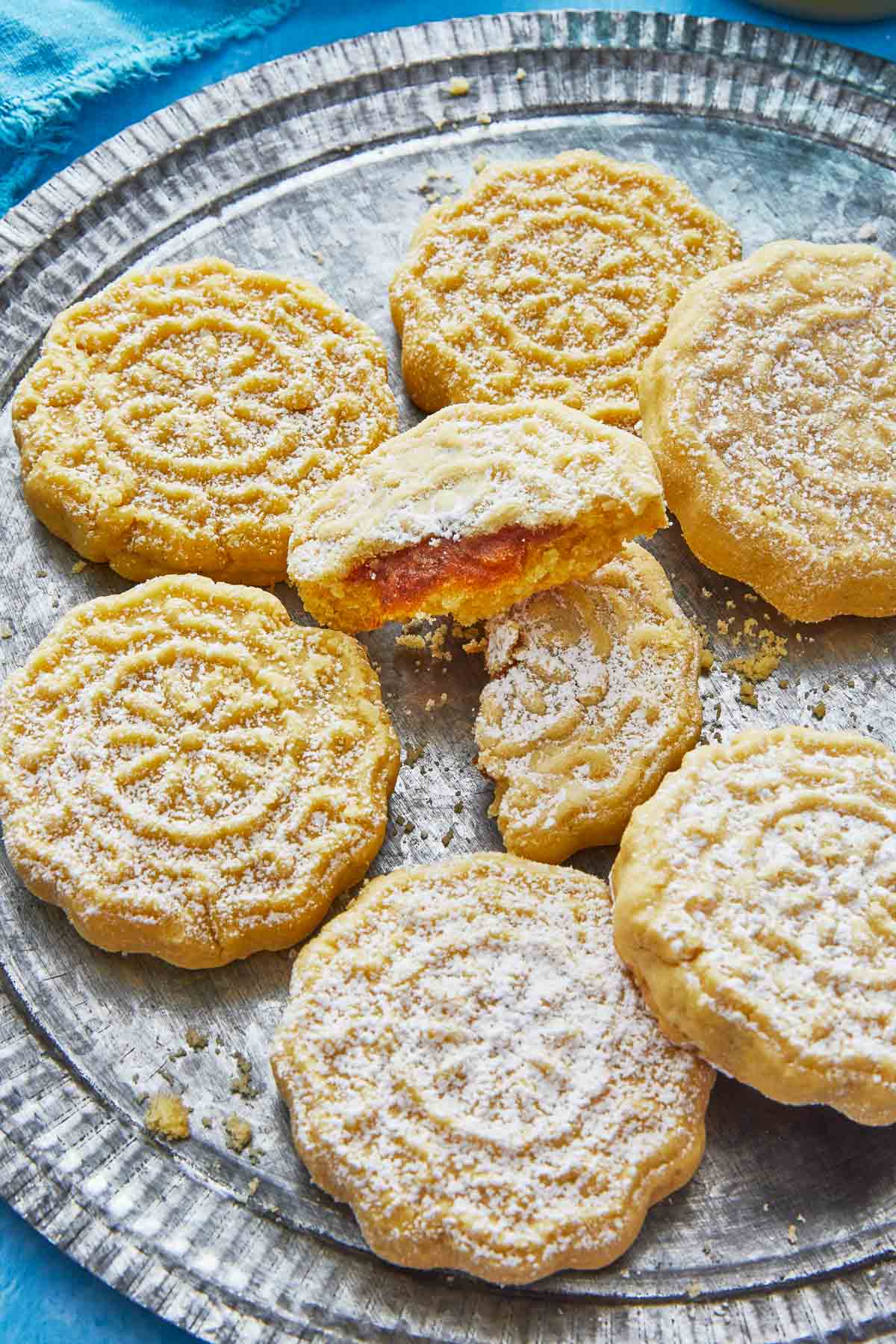
Molded, cut-out, and shaped shortbread cookies are a tradition in so many cultures for holidays and gatherings. My own Lebanese tradition of maamoul, molded filled butter cookies, is one that we look forward to as much for the making as the eating.
Maamoul’s shortbread exterior wraps around a filling, traditionally nuts or date paste. The filled dough gets its hallmark look from mallet-shaped molds that are made in a variety of shapes and designs—the shapes are used to distinguish one filled ma’amoul type from another. For this maamoul recipe I used date paste.
Maamoul-making is one of those projects that invites creativity and also: a healthy dose of stress release! My Aunt Hilda, the maamoul maven of our family, showed me how fun it is to press the soft dough into the domed maamoul mold, fill, seal the dough closed and then turn the mold over with a healthy whack on the counter to release the cookie.
With every whack, she looked up with a sly smile to see if I was as excited as she was about all the racket we were making! Make these beautiful date-filled cookies and add them to your list of favorite sweet treats right alongside Italian Pizzicati, Egyptian Ghorayebah, and Turkish Delights.
Table of Contents
- What is ma’amoul?
- What is in Maamoul?
- How to Make Maamoul
- How to Clarify Butter
- What is Mahleb?
- How Do You Shape Ma’amoul?
- Tips and Tricks for Making Maamoul
- Can you make Maamoul Ahead of Time?
- How to Serve Maamoul
- More Cookies and Desserts
- The Mediterranean Dish Cookbook
- Maamoul (Date Filled Cookies) Recipe
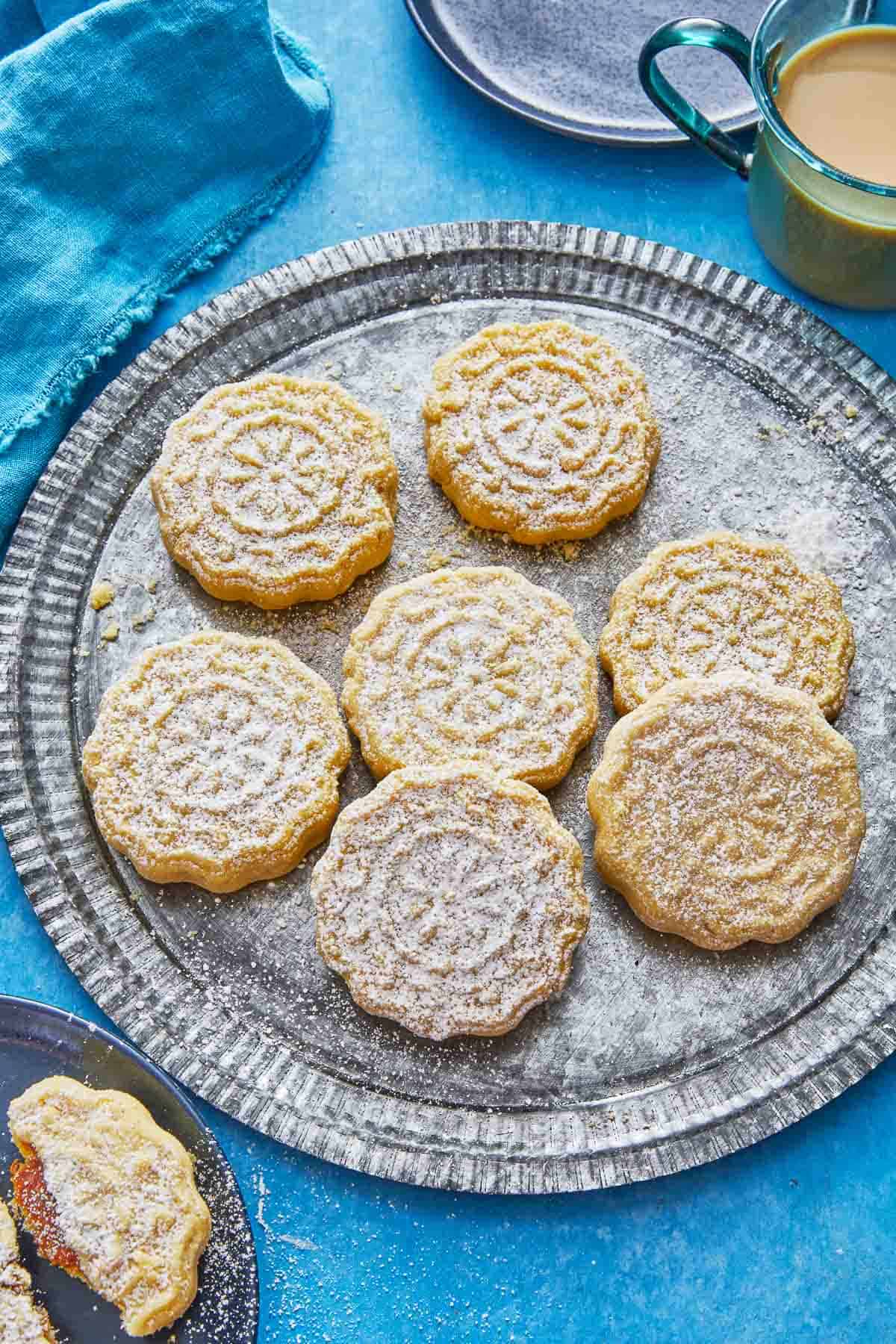
What is ma’amoul?
Maamoul is a shortbread-style cookie made with either flour or semolina. You can fill maamoul with date paste as I do in this recipe, or use ground pistachios or walnuts. Creative bakers use maamoul molds or other tools to create the decorative pattern on the cookie before dusting it with powdered sugar.

What is in Maamoul?
- Clarified butter or Ghee: Clarified butter gives the cookies a light nutty flavor and helps to keep its neutral coloring.
- Sugar: Only 3 tablespoons in the dough then its finished with a dusting of confectioners sugar.
- Egg: This adds, protein moisture and helps bind the ingredients.
- Orange blossom water or vanilla extract: If you can’t find the floral orange blossom water then vanilla extract will work just as well.
- Semolina flour and All Purpose Flour: The flour combination helps to create a soft, pliable dough that shapes easily to the mold designs.
- Mahleb: This ground spice can be found in Middle Eastern markets, but if you can’t find it then just replace the exact amount with flour.
- Milk: Use whatever you have in your house. It adds moisture to the dough.
- Date paste or puree pitted Medjool dates: This is the slightly sweet fruit filling.
How to Make Maamoul
Whisk clarified butter (ghee), sugar, eggs and blossom water together: In a stand mixer fitted with the whisk attachment or using a hand-held mixer, beat the butter first on medium, then on high speed in a large bowl until creamy and light, about 3 minutes. Scrape down the sides of the bowl and add the sugar, egg, and orange blossom water or vanilla extract. Beat until the mixture is thick, pale, and creamy, another 2-3 minutes. Scrape down the sides of the bowl once or twice during beating.
Add the flours and mahleb: If using a stand mixer, remove the bowl from the stand. Add the semolina, all-purpose flour. If using mahleb, add that here too. Use a spoon or rubber spatula to combine the ingredients together until you have a crumbly dough that holds together when squeezed.
Check the dough: The dough is too wet if it stays on your fingertips when squeezed. Add all-purpose flour 1 tablespoon at a time, stir and squeeze. If the dough feels dry (you’ll see cracking), add milk 1 tablespoon at a time, stir and squeeze. Squeeze the dough as you work, until the dough is smooth, pliable, and soft.
Let the dough rest: Set the dough aside to rest for about 15 minutes. You want the flour to absorb the moisture. The dough should be soft and pliable after resting. Add more flour or milk if needed to reach the proper consistency (another rest after this is not necessary).
To shape and bake the dough: Portion out a 1 ounce piece of dough about the size of a walnut or tablespoon. Shape it into a ball by rolling the dough between the palms of your hands.
To shape maamoul using a mold. Coat the interior of the mold with flour and knock out the excess. Do this before molding each cookie to help release the molded dough. Place the dough ball into the mold and press into the center of the ball to create a hollow space in the center. This will push the dough up above the edges around the perimeter of the mold. Roughly shape about a tablespoon of date paste into a ball and drop it into the hollowed space. Use the displaced dough from around the edges of the mold cavity to enclose the date ball, covering it completely. Smooth the dough flat.
Turn the mold face down and tap the top corner of the mold head firmly on the work surface. Whack it once or twice to release the cookie. Carefully transfer the cookie to the prepared baking sheet and place them 1-inch apart.
To shape ma’amoul by hand. Dust your work surface with flour. Use your hand or a rolling pin dusted with flour to flatten the dough ball to about ¼-inch thick in an oblong shape, about 2 1/2-inches long by 1 1/2 inches wide. Shape a tablespoon of date paste into a log similar in shape but smaller than the flattened dough. Lay the log of date paste in the center of the dough and cover the date filling with the dough. Turn the log over, continuing to smooth and shape it by hand into a log, ensuring there are no cracks. Use a fork to press or a strawberry huller to pinch the top of the dough in a deep, decorative pattern, piercing all the way to the date filling. Carefully transfer the cookies to the prepared baking sheets and place them 1 inch apart.
Shape the cookies until all the dough is used: Repeat the shaping process with a mold or by hand until the filling and dough are used up.
Bake the cookies: Bake the cookies, one sheet pan at a time, in the center of the oven, for 15-17 minutes, or until the cookies are a pale golden brown. Check the cookies frequently in the last 5 minutes of cook time to check for cracking. If the tops begin to crack, immediately remove the cookies from the oven.
How to Clarify Butter
If clarifying your own butter, melt 2 sticks of butter in a saucepan over low heat. Leave it undisturbed, until completely melted, about 15 minutes. During this time the solids will separate. Leave the solids behind and use the clarified butter. Here’s how:
- Skim off any solids that float on top of the butter with a spoon.
- Pour off the golden clarified butter into a small bowl, leaving behind the solids on the bottom of the pan. You should have 3/4 cup clarified butter.
- Cool the clarified butter to room temperature so it becomes solid. Alternatively, you can refrigerate it to speed up the process, then bring it to room temp. It must be solid to use in this recipe.
You can purchase clarified butter, also called ghee at well-stocked supermarkets if the idea of making it feels like too much. Use high quality store-bought ghee made from actual butter, not oil with butter flavoring. Whipping the clarified butter in this recipe contributes to the light, melt-in-your-mouth quality of maamoul cookies.
What is Mahleb?
Bakers with access to mahlab, a spice ground from the kernel of the St. Lucie cherry, use it in maamoul recipes to impart a delicate almond flavor.
Mahleb (also known throughout the Mediterranean as mahlabh, mahaleb, mahleppi, and mahlebi) has a scent and flavor akin to freshly ground raw almonds. It’s totally optional for this recipe, but adds a nice touch if you want to pick some up at your local Middle Eastern marketplace.
- If you seek it out, make sure your mahleb is fresh and does not give off a stale scent
- Store mahleb in the freezer for longevity and freshness.

How Do You Shape Ma’amoul?
Bakers achieve the decorative pattern on maamoul cookies by using a special tool called a maamoul molds can be found in Middle Eastern markets. They are typically machine-carved in wood or made of plastic.
To shape maamoul with a mold:
- Coat the interior of a wooden maamoul mold with flour, tapping out any excess. This step is essential to releasing the cookie from the mold and must be done for every cookie.
- Place a ball of dough in the mold and press down to make a hollow space in the center.
- Fill the cavity with a small ball of date paste and cover the date filling with the cookie dough, smoothing the flat side until there are no cracks or fissures.
- Turn the mold over and whack the top corner of the mold on the work surface once or twice to release the cookie.
- Place the cookie on the cookie sheet.
To shape maamoul without a mold:
It’s easy to create beautifully shaped maamoul without a mold too. Both methods begin the same way, by forming about an ounce of dough, the size of a walnut, into a ball.
- Flatten the dough ball with your hand or roll with a rolling pin to about 1/4-inch thick in an oblong shape.
- Lay a log of date paste in the center and cover the date filling by enclosing it in the dough and sealing the edges together up over the date paste log.
- Turn the log over, continuing to smooth and shape the dough by hand. Use a fork or a strawberry huller to pierce the top in a deep, decorative pattern.
Tips and Tricks for Making Maamoul
The light, meltaway texture of maamoul means that the dough can be delicate. As with any shaped cookie, the texture of the dough is essential to achieving and holding its shape.
- Maamoul dough must be pliable enough that it doesn’t crack when shaped. If the dough is too soft, it will not hold its shape and can be difficult to release from a mold.
- Squeeze the dough after ingredients are incorporated until pliability is reached. Add a touch of milk if the dough is too dry or a touch of flour if its too soft.
- Measure flour using the spoon-in-cup method rather than scooping the flour up with the measuring cup. Never press down on flour as you would with brown sugar, otherwise there will be more flour than the recipe calls for and results will be dry.
- Watch for cracking. Keep an eye on the cookies as they bake to monitor if they are beginning to crack at the top. If the tops begin to crack, immediately remove the cookies from the oven. Place the hot sheet pan on a cooling rack and leave the cookies undisturbed until they are completely cooled.

Can you make Maamoul Ahead of Time?
Even though maamoul seems elaborate with its shape, because they hold so long at room temperature, they travel well, too. Use a buffer between layers and around the perimeter of your packing tin, Tupperware, or box. I like scrunched up wax paper for this since it protects cleanly and gently, without damaging the cookies.
- How to Store Maamoul: You can make maamoul to two weeks in advance and keep the cookies in an airtight container at room temperature.
- To Freeze Maamoul: Store them carefully in the freezer in an airtight container for up to two months. Thaw at room temperature, and dust with confectioners’ sugar just before serving.
How to Serve Maamoul
Maamoul are such pretty, delectable cookies that they stand on their own platter with ease. Traditional dessert platters or tables will also include baklawa (baklava) and other cookies such as ghraybeh butter cookies and sesame barazek cookies.
These date-filled cookies are a favorite at Christmastime, weddings, and other special events. Christian and Muslim religious traditions that include fasting include maamoul and other treats to celebrate when the fast is finished.
A portion of our every batch is always gifted to friends and my Aunt Hilda always presented them beautifully. To gift them as Hilda would, place each cookie in its own foil cup and stack them high on a plate, wrap it like the present it is in cellophane, and tie with a bow.
Whether serving maamoul for a special event or simply to enjoy with a friend, the cookie is right at home next to a cup of aromatic tea or coffee.
More Cookies and Desserts
Browse all Mediterranean recipes.
Visit Our Shop.
The Mediterranean Dish Cookbook
The Mediterranean Dish Cookbook: 120 Bold and Healthy Recipes You’ll Make on Repeat. In her book, Suzy brings cross-culturally inspired dishes from throughout the Mediterranean to you, using easy-to-find ingredients and easy-to-follow, to make your meals more vibrant, delicious, and yes — even a little healthier, too!
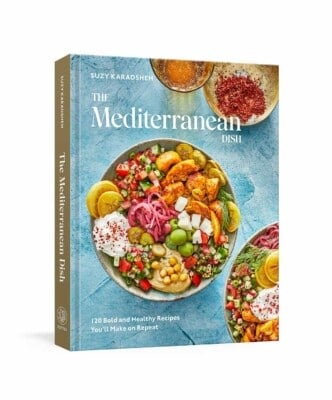
Maamoul (Date Filled Cookies)

Ingredients
- 3/4 cup ghee or clarified butter
- 3 tablespoons granulated sugar
- 1 large egg, room temperature
- 2 teaspoons orange blossom water, or vanilla extract
- 1 ¼ cups semolina flour
- 1 ¼ cups all-purpose flour, plus more as needed to finish the dough and coat the molds, if using
- 2 teaspoons mahleb, optional; replace with flour if not using
- 1-3 tablespoons milk, any fat content level, at room temperature
- ¼ cup confectioners’ sugar, for finishing
- 10 oz date paste, or 20 pureed pitted Medjool dates
Instructions
- Preheat the oven: Preheat the oven to 350° F. Line two sheet pans with parchment paper.
- Whisk clarified butter (or ghee), sugar, eggs and blossom water together: In a stand mixer fitted with the whisk attachment or using a hand-held mixer, beat the butter first on medium, then on high speed in a large bowl until creamy and light, about 3 minutes. Scrape down the sides of the bowl and add the sugar, egg, and orange blossom water or vanilla extract. Beat until the mixture is thick, pale, and creamy, another 2-3 minutes, scraping down the sides of the bowl once or twice during beating..
- Add the flours and mahleb: If using a stand mixer, remove the bowl from the stand. Add the semolina, all-purpose flour. If using mahleb, add that here too. Use a spoon or rubber spatula to combine the ingredients together until you have a crumbly dough that will hold together when squeezed.
- Check the dough: If the dough stays on your fingertips when squeezed, it is too wet. Add all-purpose flour 1 tablespoon at a time, stir and squeeze. If the dough feels dry (you’ll see cracking), add milk 1 tablespoon at a time, stir and squeeze. Squeeze the dough as you work, until the dough is smooth, pliable, and soft.
- Let the dough rest: Set the dough aside to rest for about 15 minutes, so the flour can absorb the moisture. Test the dough after resting to be sure it is soft and pliable, adding more flour or milk if needed (another rest after this is not necessary).
- To shape and bake the dough: Take a 1 ounce piece of dough about the size of a walnut or 1 tablespoon, shape into a ball by rolling the dough between the palms of your hands.
- To shape maamoul using a mold: Coat the interior of the mold with flour and knock out the excess. Do this before molding each cookie to help release the molded dough. Place the dough ball into the mold and press into the center of the ball to create a hollow space in the center. This will push the dough up above the edges around the perimeter of the mold. Roughly shape about a tablespoon of date paste into a ball and drop it into the hollowed space. Use the displaced dough from around the edges of the mold cavity to enclose the date ball, covering it completely. Smooth the dough flat.
- Turn the mold face down and tap the top corner of the mold head firmly on the work surface (whack!) once or twice to release the cookie. Carefully transfer the cookie to the prepared baking sheet and place them 1-inch apart.
- To shape maamoul by hand: Dust your work surface with flour. Use your hand or a rolling pin dusted with flour to flatten the dough ball to about ¼-inch thick in an oblong shape, about 2 1/2-inches long by 1 1/2-inches wide. Shape a tablespoon of date paste into a log similar in shape but smaller than the flattened dough. Lay the log of date paste in the center of the dough and cover the date filling by enclosing it in the dough and sealing the edges together up over the date paste log. Turn the log over, continuing to smooth and shape the dough by hand into a log, ensuring there are no cracks. Use a fork to press or a strawberry huller to pinch the top of the dough in a deep, decorative pattern, piercing all the way to the date filling. Carefully transfer the cookies to the prepared baking sheets and place them 1 inch apart.
- Shape the cookies: Repeat the shaping process with a mold or by hand with the rest of the dough and date filling.
- Bake the cookies: Bake the cookies, one sheet pan at a time, in the center of the oven, for 15-17 minutes, or until the cookies are a pale golden brown. Check the cookies frequently in the last 5 minutes of cook time to check for cracking. If the tops begin to crack, immediately remove the cookies from the oven.
- Cool and serve the cookies: Allow the cookies to cool completely, undisturbed, on the pan, at least one hour. Sift confectioners’ sugar over the cookies and give them a fresh dusting again just before serving.
- To store the cookies: Store the cookies in an airtight container for up to two weeks at room temperature, or for two months frozen.
Notes
- Maamoul dough must be pliable enough that it doesn’t crack when shaped. But if the dough is too soft, it will not hold its shape and can be difficult to release from a mold. Hands will be the guide, squeezing the dough after ingredients are incorporated and adding a touch of milk if too dry, a touch of flour if too soft, until pliability is reached.
- The way the flour is measured matters. Be sure to measure using the spoon-in-cup method rather than scooping the flour up with the measuring cup.
- Watch for cracking. Keep an eye on the cookies as they bake to monitor if they are beginning to crack at the top. If the tops begin to crack, immediately remove the cookies from the oven. Place the hot sheet pan on a cooling rack and leave the cookies undisturbed until they are completely cooled.
- Visit our shop to browse quality Mediterranean ingredients including olive oils, honey, jams and spices.




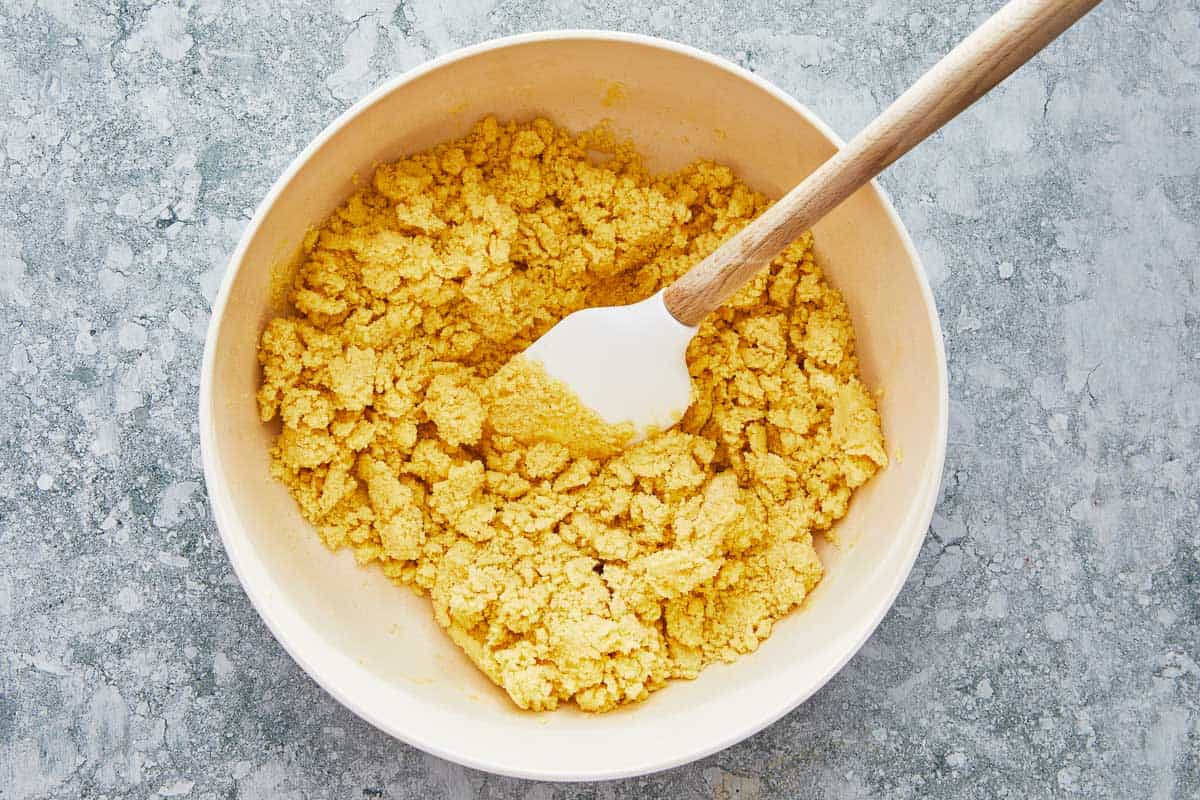
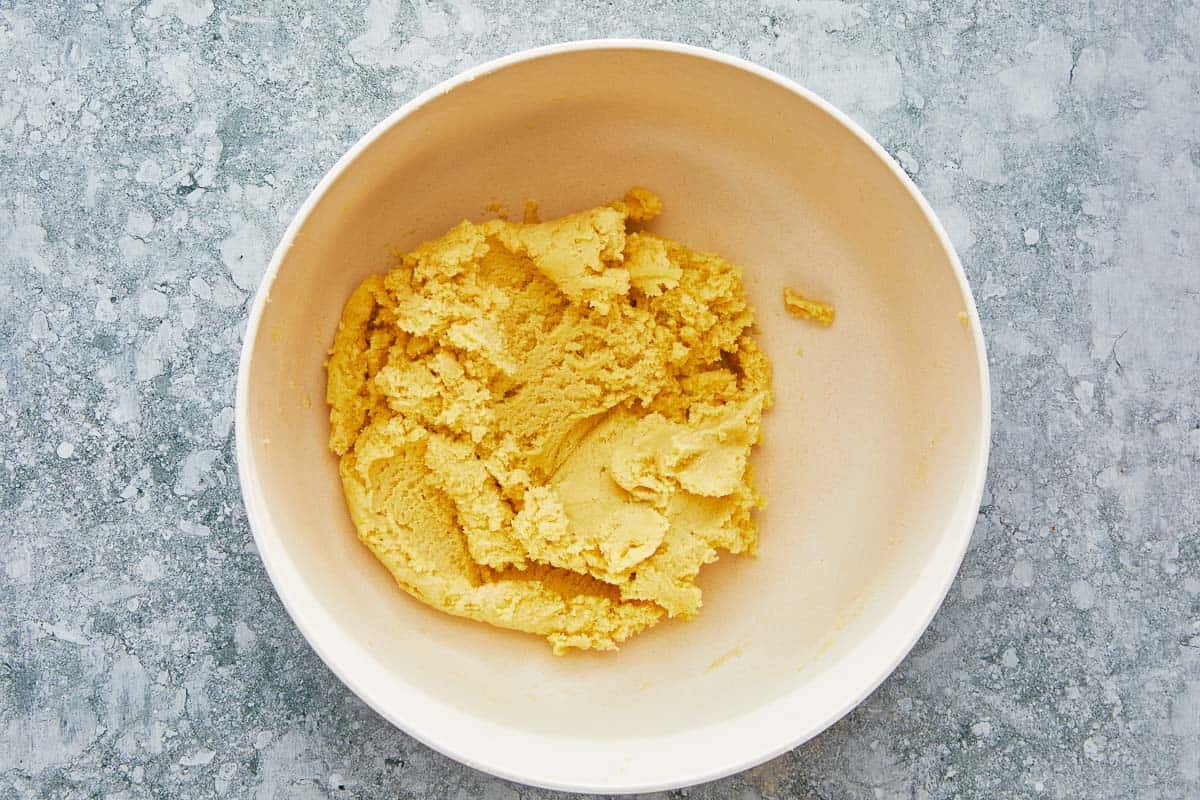
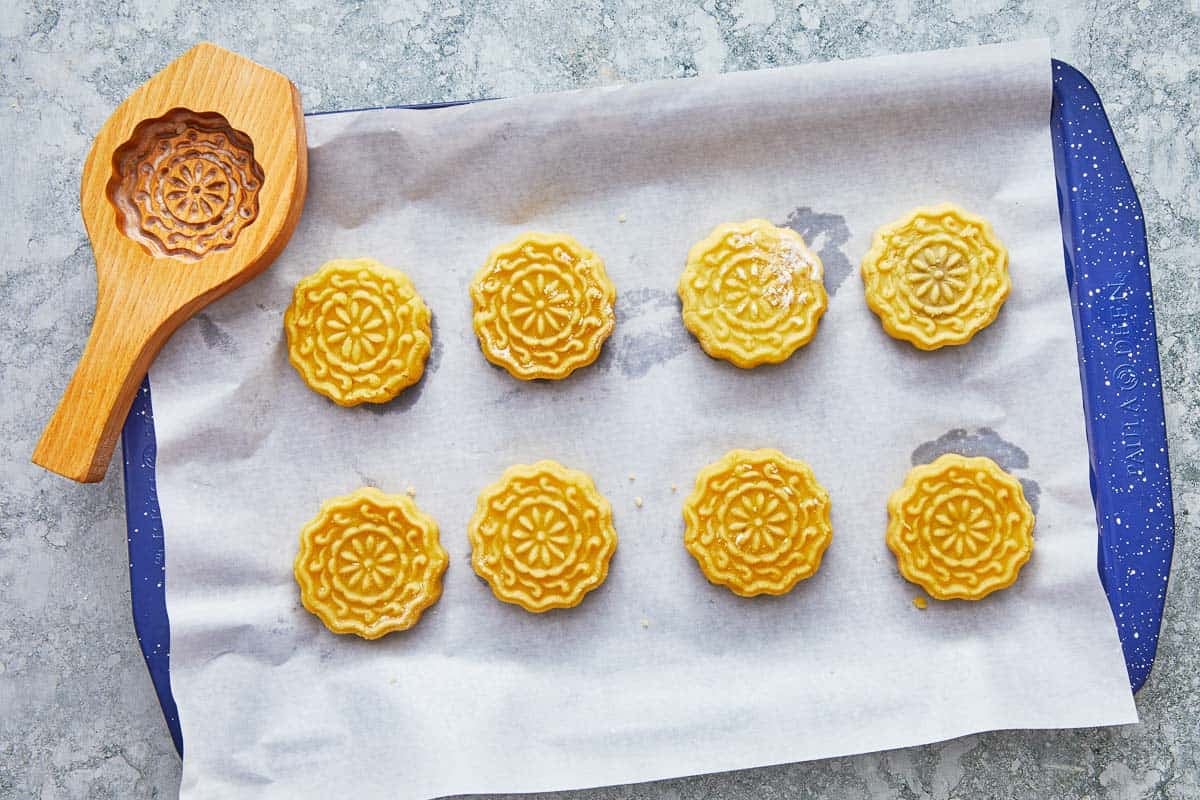
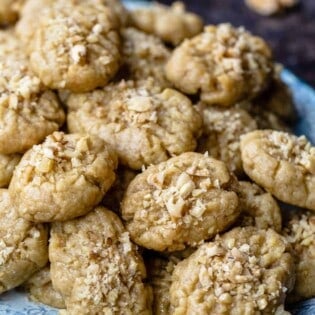



Recipe looks wonderful, but this is the second recipe on your site that won’t include the picture when you print.
Just wanted to pass that along so your tech team can fix this.
Thank you
Hello! We’re aware of the issue, but, unfortunately, it’s not something we’re able to fix. I’m so sorry. Hope you’ll be able to enjoy the recipes anyway!